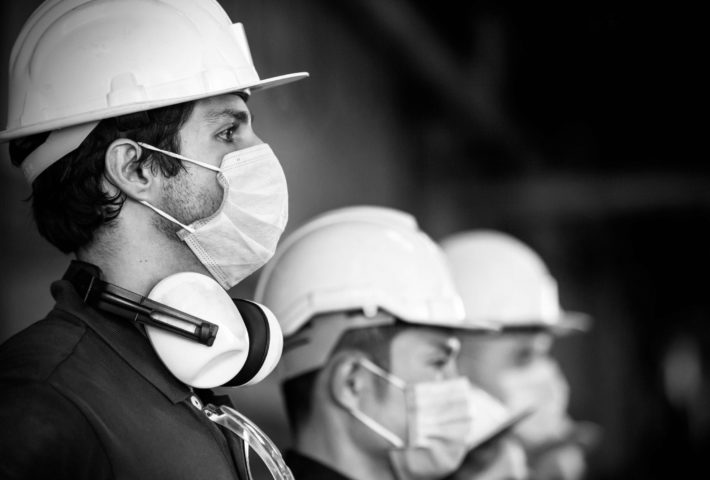Daily Huddle Best Practices for COVID-19 Protocol
“Shelter in place” ordinances have been rolled out in towns and cities throughout the nation, but construction has been deemed “essential” in many places. I can’t think of a better word than this for the work we do. This means our industry can continue showing up each day and build resources for the people in our communities. Our work has significant purpose and value. It touches the lives of millions of people by maintaining our infrastructure and creating the facilities where people work, learn, celebrate, worship, and heal.
Field leaders in our industry have a lot to manage during the COVID-19 pandemic. There are the ever-evolving mitigation efforts to prevent the spread of the virus on our teams, and our efforts to ensure we’ve developed the best response protocols if a worker becomes sick. There are also challenges in phasing work to maintain social distancing requirements.
But perhaps the most important aspect involves supporting our workers emotionally. People on your team may be down to one income in their family due to layoffs and furloughs. They may be separated from a sick family member, or worried about the health of an elderly parent who lives far away. Many are adjusting to new home-schooling requirements with their kids. Whatever individual stressors people may have, at a minimum we know everyone is worried about staying healthy and employed in these volatile times.
Modifying Daily Huddle Best Practices
It can be tempting to abandon Lean on our projects during this unusual time or feel like it’s not possible to consistently maintain our typical practices when so much has become different. But these are exactly the kinds of events that Lean is built for. Our responsibilities on our projects and with our teams have greatly increased, and so have the constraints that are working against us. Several people have reached out to Joe and me with questions about how they can continue to practice Lean in the field during this pandemic, and we’ve provided the following answers, which we’re sharing here.
1. Rethink your huddle size
Due to social distancing, many firms are limiting gatherings of people in one area. If your daily huddle group is larger than 10 people, consider running two huddles at different times. For example, you could split into smaller groups that are focused on specific building areas, trade partners handoffs, floors, or shifts. Maintaining a standard 6-foot separation between individuals is a must. This can be achieved by placing markers on the floor or by having folks spread out by an arm’s length spacing.

Workers layout daily huddle social distancing markers on a Skiles Group jobsite. Photo provided by Skiles Group Senior Superintendent Buddy Brumley.
2. Rethink your huddle location
If you are currently running your huddles in the trailer, it may be time to move to a larger location. Some teams have moved outside or to a part of the jobsite where there is more room to spread out. If meeting in person has constraints, then moving to a virtual huddle can be an option. Microsoft Teams, Google Hangouts, Zoom, and other virtual tools can be very simple to do from your phone or iPad. This can still help everyone continue to collaborate as a team even though they are kept apart.
3. New agenda items for huddle
The normal agenda items we recommend asking the trade partner foreman at the daily huddle are:
What are you working on?
Where are you working?
How many crews/workers are on-site?
What are your constraints/needs?
What material deliveries are coming up?
But considering our current events and the stressors related to the pandemic, we recommend starting off your Lean huddles discussing the following:
Safety changes or requirements
It is important that the teams be regularly updated on any changes to your COVID-19-related safety policies. For example, some projects are utilizing new badging requirements, temperature checks, or handwashing breaks. It is important that these changes are being communicated at these huddles so foremen can ensure their workers understand your protocols.
Minimizing workers in a space
The standard questions “where are you working?” and “how many crews/workers are on-site?” have greater significance now, since it is crucial that not too many people be confined in one space. Some projects have moved to multiple shifts to allow workers in any given area to be less than 10. Appropriate time and attention should be invested in carefully discussing this every morning so there is no congestion in a workspace and all social distancing protocols are followed.
Worker’s Mental Health
Make sure some time is spent at the huddle checking in personally with your last planners. Questions you ask might include finding out if everyone has enough food, toilet paper, and so on. Allow them time to share stories about any hardships they are experiencing (people they know who have gotten sick, being down to one income, and so on). The strongest teams can be built during a crisis. This kind of open communication builds trust. It also helps your team members to connect as people and offer support to each other.
If you have comments or any suggestions you’d like to add, we hope you’ll comment below on and share what’s working. We’d love to hear from you.
By: Keyan Zandy, COO
Skiles Group
For more from Keyan, see The Lean Builder – A Builder’s Guide to Applying Lean Tools in the Field or Connect with Keyan on LinkedIn.









